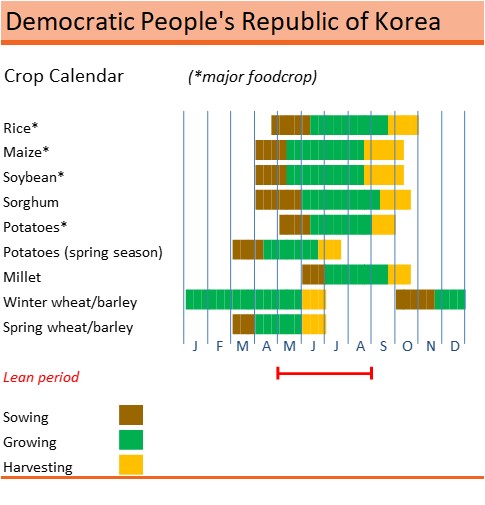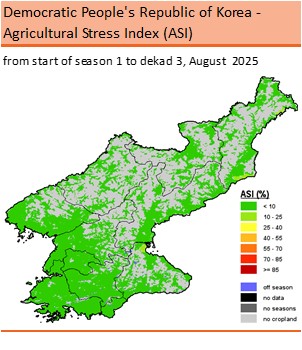Reference Date: 15-September-2025
|
FOOD SECURITY SNAPSHOT
-
Below‑average precipitation amounts forecast between October and December 2025
-
Favourable weather conditions benefitted the 2025 main season food crops
|
Below‑average precipitation amounts forecast between October and December 2025
Planting of the 2025/26 minor winter cereal crops, mainly wheat and barley, is expected to start in October and finalize at the end of November. Weather forecasts point to below‑average precipitation amounts across the main cereal producing southern and central areas between October and December 2025, which could constrain planting operations and negatively affect crop establishment.
Favourable weather conditions benefitted the 2025 main season food crops
Harvesting of the 2025 main food crops, which account for about 90 percent of total annual production and consist mostly of rice and maize, plus small quantities of soybeans, potatoes, millet and sorghum, is ongoing and it is expected to finalize at the end of October. Seasonal rains began on time in mid‑April 2025, with average to above‑average and well‑distributed precipitation amounts between early May and mid‑August, favouring planting operations and crop development. In the second half of August, precipitation amounts were well above the average in western parts of the country, including the main cereal producing provinces of North and South Pyongan as well as North Hwanghae. Temporary flooding occurred in localized low‑lying areas, but no impact on crops has been reported. Remote sensing data, as of late August, just before the start of the harvest, indicated good vegetation conditions across most of the country, inferring to generally favourable yields and production prospects (see ASI map). Harvesting of the 2024/25 minor winter and spring cereal crops, mainly wheat and barley, which account for about 10 percent of total annual production, was completed last June and weather conditions during the cropping season were generally favourable.
Disclaimer: The designations employed and the presentation of material in this information product do not imply the expression of any opinion whatsoever on the part of FAO concerning the legal status of any country, territory, city or area or of its authorities, or concerning the delimitation of its frontiers or boundaries.
This brief was prepared using the following data/tools:
FAO/GIEWS Country Cereal Balance Sheet (CCBS)
https://www.fao.org/giews/data-tools/en/
.
FAO/GIEWS Food Price Monitoring and Analysis (FPMA) Tool
https://fpma.fao.org/
.
FAO/GIEWS Earth Observation for Crop Monitoring
https://www.fao.org/giews/earthobservation/
.
Integrated Food Security Phase Classification (IPC)
https://www.ipcinfo.org/
.
|
|


|
|